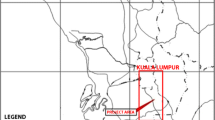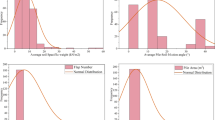Abstract
This study aimed to assess particle swarm optimization (PSO) enhanced with an artificial neural network (ANN) for the prediction of the Pul (pullout resistance of helical piles in pure cohesionless soils). To make data sets of training and testing as to the expanded predictive models, 36 laboratory experiments were performed. The database involved 27 experiments for the training data sets (e.g., 80% of the whole database) and 9 experiments for the testing data sets (e.g., a range of 20% of the whole database). In addition, variables of the ANN algorithm (e.g., neurons in each hidden layer) and PSO algorithm, such as population size, were optimized utilizing a series of trial-and-error processes. The input parameters that were used in the analysis include density, embedment ratio, shaft base diameter, and shaft diameter, where the output was taken and the laboratory Pul determined. The selection of these parameters is because the Pul is affected by the geologic conditions, helical pile’s configuration, and penetration depth. After performing the sensitivity analysis, the optimized architecture, 4 × 8 × 1 is specified for the structure of ANN. As a result, both models, ANN and PSO–ANN, presented excellent prediction performance. Note that the PSO–ANN method can provide a more accurate network outputs in predicting measured values compared to the conventional ANN model. Based on R2, RMSE and VAF values of, 0.999, 0.0350 and 99.9978, as well as, 0.999, 0.0379 and 99.998, were determined for the normalized training and testing data sets in the optimized PSO–ANN network, respectively. However, in the ANN model with four neurons in each hidden layer, the R2 as well as RMSE for the non-normalized training and testing data sets were (0.99985 and 7.99007) and (0.99990 and 11.97427), respectively, which confirms the superiority of the proposed PSO–ANN model in predicting the Pul.









Similar content being viewed by others
References
McCulloch WS, Pitts W (1943) A logical calculus of the ideas immanent in nervous activity. Bull Math Biophys 5:115–133
Hebb D (1949) The organization of behavior: a neurophysiological approach. Wiley, Hoboken
Mosallanezhad M, Moayedi H (2017) Developing hybrid artificial neural network model for predicting uplift resistance of screw piles. Arab J Geosci 10:10
Gandomi AH, Alavi AH (2012) A new multi-gene genetic programming approach t o non-linear system modeling. Part II: geotechnical and earthquake engineering problems. Neural Comput Appl 21:189–201
Demuth H, Beale M (2000) Neural network toolbox: for use with matlab: computation, visualization, programming: user’s guide, version 4. The Mathworks, Natick
Govindaraju RS, Rao AR (2013) Artificial neural networks in hydrology. Springer, New York
Taylor G (1996) Neural networks and their applications. Wiley, Hoboken
Moayedi H, Huat B, Kazemian S, Asadi A (2010) Optimization of Shear behavior of reinforcement through the reinforced slope. Electron J Geotech Eng 15:93–104
Raftari M, Kassim KA, Rashid ASA, Moayedi H (2013) Settlement of shallow foundations near reinforced slopes. Electron J Geotech Eng 18:797–808
Marto A, Latifi N, Janbaz M, Kholghifard M, Khari M, Alimohammadi P, Banadaki AD (2012) Foundation size Effect on modulus of subgrade reaction on sandy soils. Electron J Geotech Eng 17:2523–2530
Latifi N, Rashid ASA, Siddiqua S, Abd Majid MZ (2016) Strength measurement and textural characteristics of tropical residual soil stabilised with liquid polymer. Measurement 91:46–54
Jiao JJ, Wang XS, Nandy S (2005) Confined groundwater zone and slope instability in weathered igneous rocks in Hong Kong. Eng Geol 80:71–92
Spagnoli G (2013) Some considerations regarding the use of helical piles as foundation for offshore structures. Soil Mech Found Eng 50:102–110
Alkroosh I, Nikraz H (2014) Predicting pile dynamic capacity via application of an evolutionary algorithm. Soils Found 54:233–242
Gao W, Dimitrov D, Abdo H (2018) Tight independent set neighborhood union condition for fractional critical deleted graphs and ID deleted graphs. Discret Contin Dyn Syst S 12:711–721
Moayedi H, Hayati S (2018) Applicability of a CPT-based neural network solution in predicting load-settlement responses of bored pile. Int J Geomech 18:06018009
Gao W, Guirao JLG, Abdel-Aty M, Xi W (2019) An independent set degree condition for fractional critical deleted graphs. Discrete Contin Dyn Syst S 12:877–886
Moayedi H, Mosallanezhad M, Mehrabi M, Safuan ARA (2018) A systematic review and meta-analysis of artificial neural network application in geotechnical engineering: theory and applications. Neural Comput Appl 35:1–24
Huang C-L, Dun J-F (2008) A distributed PSO–SVM hybrid system with feature selection and parameter optimization. Appl Soft Comput 8:1381–1391
Muthusamy S, Manickam LP, Murugesan V, Muthukumaran C, Pugazhendhi A (2019) Pectin extraction from Helianthus annuus (sunflower) heads using RSM and ANN modelling by a genetic algorithm approach. Int J Biol Macromol 124:750–758
Gao W, Wu H, Siddiqui MK, Baig AQ (2018) Study of biological networks using graph theory. Saudi Journal of Biological Sciences 25:1212–1219
Safaei MR, Karimipour A, Abdollahi A, Truong Khang N (2018) The investigation of thermal radiation and free convection heat transfer mechanisms of nanofluid inside a shallow cavity by lattice Boltzmann method. Phys Stat Mech Appl 509:515–535
Nguyen H, Moayedi H, Foong LK, Al Najjar HAH, Jusoh WAW, Rashid ASA, Jamali J (2019) Optimizing ANN models with PSO for predicting in short building seismic response. Eng Comput 36:1–15
Gao W, Moayedi H, Shahsavar A (2019) The feasibility of genetic programming and ANFIS in prediction energetic performance of a building integrated photovoltaic thermal (BIPVT) system. Sol Energy 183:293–305
Yaseen ZM, Minh Tung T, Kim S, Bakhshpoori T, Deo RC (2018) Shear strength prediction of steel fiber reinforced concrete beam using hybrid intelligence models: a new approach. Eng Struct 177:244–255
Toan B, Tram N, Bay V, Thanh N, Pedrycz W, Snasel V (2018) Application of particle swarm optimization to create multiple-choice tests. J Inform Sci Eng 34:1405–1423
Ho Pham Huy A, Nguyen Ngoc S, Van Cao K, Ho-Huu V (2018) Parameter identification using adaptive differential evolution algorithm applied to robust control of uncertain nonlinear systems. Appl Soft Comput 71:672–684
Dieu Tien B, Viet-Ha N, Nhat-Duc H (2018) Prediction of soil compression coefficient for urban housing project using novel integration machine learning approach of swarm intelligence and multi-layer perceptron neural network. Adv Eng Inform 38:593–604
Nazir R, Chuan HS, Niroumand H, Kassim KA (2014) Performance of single vertical helical anchor embedded in dry sand. Measurement 49:42–51
Moayedi H, Rezaei A (2017) An artificial neural network approach for under-reamed piles subjected to uplift forces in dry sand. Neural Comput Appl 31:1–10
Moayedi H, Hayati S (2018) Artificial intelligence design charts for predicting friction capacity of driven pile in clay. Neural Comput Appl 31:1–17. https://doi.org/10.1007/s00521-018-3555-5
Canakci H, Baykasoglu A, Gullu H (2009) Prediction of compressive and tensile strength of Gaziantep basalts via neural networks and gene expression programming. Neural Comput Appl 18:1031–1041
Bunawan AR, Momeni E, Armaghani DJ, Rashid ASA (2018) Experimental and intelligent techniques to estimate bearing capacity of cohesive soft soils reinforced with soil-cement columns. Measurement 124:529–538
Gao W, Guirao JLG, Basavanagoud B, Wu J (2018) Partial multi-dividing ontology learning algorithm. Inf Sci 467:35–58
Bui X-N, Nguyen H, Le H-A, Bui H-B, Do N-H (2019) Prediction of blast-induced air over-pressure in open-pit mine: assessment of different artificial intelligence techniques. Nat Resour Res 29:1–21. https://doi.org/10.1007/s11053-019-09461-0
Gao W, Wang W, Dimitrov D, Wang Y (2018) Nano properties analysis via fourth multiplicative ABC indicator calculating. Arab J Chem 11:793–801
Nguyen H, Bui X-N, Bui H-B, Mai N-L (2018) A comparative study of artificial neural networks in predicting blast-induced air-blast overpressure at Deo Nai open-pit coal mine, Vietnam. Neural Comput Appl 31:1–17
Moayedi H, Mosallanezhad M, Mehrabi M, Safuan ARA, Biswajeet P (2018) Modification of landslide susceptibility mapping using optimized PSO-ANN technique. Eng Comput 36:1–18. https://doi.org/10.1007/s00366-018-0644-0
Nguyen H, Bui X-N, Tran Q-H, Mai N-L (2019) A new soft computing model for estimating and controlling blast-produced ground vibration based on hierarchical K-means clustering and cubist algorithms. Appl Soft Comput 77:376–386
Sharma LK, Vishal V, Singh TN (2017) Developing novel models using neural networks and fuzzy systems for the prediction of strength of rocks from key geomechanical properties. Measurement 102:158–169
Karimipour A, D’Orazio A, Goodarzi M (2018) Develop the lattice Boltzmann method to simulate the slip velocity and temperature domain of buoyancy forces of FMWCNT nanoparticles in water through a micro flow imposed to the specified heat flux. Phys Stat Mech Appl 509:729–745
Goodarzi M, D’Orazio A, Keshavarzi A, Mousavi S, Karimipour A (2018) Develop the nano scale method of lattice Boltzmann to predict the fluid flow and heat transfer of air in the inclined lid driven cavity with a large heat source inside, two case studies: pure natural convection and mixed convection. Phys Stat Mech Appl 509:210–233
Alrashed AAAA, Karimipour A, Bagherzadeh SA, Safaei MR, Afrand M (2018) Electro- and thermophysical properties of water-based nanofluids containing copper ferrite nanoparticles coated with silica: experimental data, modeling through enhanced ANN and curve fitting. Int J Heat Mass Transf 127:925–935
Moayedi H, Hayati S (2018) Modelling and optimization of ultimate bearing capacity of strip footing near a slope by soft computing methods. Appl Soft Comput 66:208–219
Author information
Authors and Affiliations
Corresponding author
Ethics declarations
Conflict of interest
The authors declare that there is no conflict of interest in presenting this manuscript.
Additional information
Publisher's Note
Springer Nature remains neutral with regard to jurisdictional claims in published maps and institutional affiliations.
Rights and permissions
About this article
Cite this article
Wang, B., Moayedi, H., Nguyen, H. et al. Feasibility of a novel predictive technique based on artificial neural network optimized with particle swarm optimization estimating pullout bearing capacity of helical piles. Engineering with Computers 36, 1315–1324 (2020). https://doi.org/10.1007/s00366-019-00764-7
Received:
Accepted:
Published:
Issue Date:
DOI: https://doi.org/10.1007/s00366-019-00764-7




